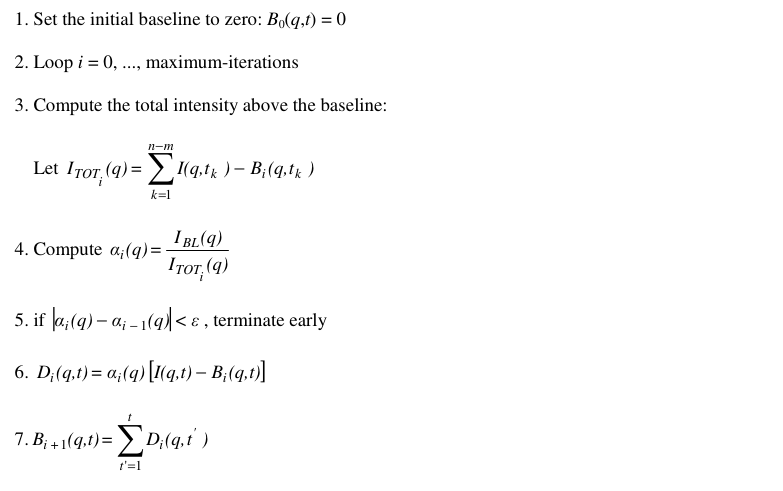
 |
Manual |
The Integral Baseline method is based upon the assumption that capillary fouling deposits are formed in proportion to the sample concentration while exposed to the beam, and that neither the buffer nor the instrumental background are contributing to this effect. Assuming further that the beam characteristics and detector response are constant throughout the duration of the experiment and the reference buffer's signal has been correctly subtracted from the experimental data, then the remaining positive signal contains the sample's scattering plus any capillary fouling.
For a first approximation, we suppose that no "cleaning" of the capillary takes place during the elution phase, that the capillary fouling is proportional to the sample's scattering intensity while exposed to the beam, and that the proportionality coefficient is species-independent. Here species refers to different aggregation states of a macromolecule (monomers, dimers, etc.) or the presence of different macromolecular entities (e.g., ligand-receptor). While especially in the latter case this might be a rather strong assumption, it is a first approximation that could be further refined if new experimental evidences appears. Additionally, the possibility of using different coefficients for each species is already present in our implementation (see below). However, fine-tuning it might be not a straightforward task, and therefore we have for the moment restricted our analysis to the species-independent case.
If the dataset I(q,t) with frames T = {t1, t2, ...tn} has been correctly buffer subtracted, then I(q,t) = 0 when only buffer is present and no fouling deposits are present. To utilize our procedure, it is necessary to have a steady-state signal after all species have eluted and only buffer remains in the flowing solution. If this has not been achieved experimentally, it is difficult to proceed further. In the following, we will then assume a steady-state end signal. A robust procedure to evaluate whether the steady-state has effectively been reached has been implemented (see main Help).
Given m end frames of steady-state signal (m > 10 at least, but the longer this stretch, the better), we define ts1 and tsm as the beginning and ending frames of this region. Then, we can define the steady-state average:

Now, if IBL(q) ≈ 0, then the signal has returned to a pure buffer condition, and no correction is needed. If IBL(q) < 0, it means that net deposited material was removed from the cell, and this is contrary to our assumption. If IBL(q) > 0 instead means that capillary fouling deposits were formed, which is the case considered from now on. We first define the unknown baseline correction for the capillary fouling deposits as B(q,t). Notice that B(q,t) should be monotonically increasing with t if deposits are only accumulated.
Let D(q,tk) = B(q,tk) - B(q,tk-1) be the deposits accumulated from tk-1 to tk. From our hypothesis, we assume that D(q,tk) is proportional to I(q,tk-1) - B(q,tk-1 ), i.e. the signal
above previously accumulated deposits. Specifically:

where α(q) is a constant of proportionality. The goal of the integral baseline subtraction is to compute B(q,t) given I(q,t) [and given IBL(q), which is actually a subset average of I(q,t)].
The implemented integral baseline procedure computes B(q,t) iteratively. This follows naturally from the fact that we are only accumulating deposits as a proportion of the signal above the baseline and as computed improved approximations for B, we can compute an improved approximation of the signal from the species in solution. The algorithm proceeds as follows:
Note: q is fixed during a cycle, and this procedure is repeated for each q

where ε is the threshold value defined by the user (default value: 0).
Note that B(q,t0) remains equal to zero throughout the algorithm. Physically, this represents the fact that no deposit due to irradiation is present at t0 since no sample exposure has occurred yet. It does not mean that the measured intensity at t0 is zero.
Testing of the integral baseline algorithm was done with multiple simulated Gaussian data sets. For each Gaussian data set, a simulated experimental data set was created by adding α multiplied by intensity to simulate deposits and additionally random noise. The simulated experimental data were processed through the algorithm and correctly recovered the simulated Gaussian data.
This document is part of the UltraScan Software Documentation
distribution.
Copyright © notice.
The latest version of this document can always be found at:
Last modified on December 13, 2017.